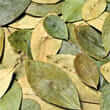Background
- The coca plant (Erythroxylum coca), or "coca," is native to the Andean region in western South America. Coca leaves have been used widely by native South American tribes for thousands of years. It has been suggested that the use of the coca plant was originally reserved for priests and royalty in ancient South America and was used for religious purposes.
- Traditionally, coca plant products (for example, coca leaves, coca leaf tea) have been used for reducing pain, decreasing hunger, and for their stimulant effects. Cocaine, an alkaloid that is processed from the coca plant, is a highly addictive stimulant. In 1999, an estimated 30% of drug-related visits to emergency departments were due to cocaine toxicity. Cocaine production and trade is illegal in most countries. Unprocessed coca leaf, however, may be legal in some South American countries because the use of coca leaves has traditionally been considered to be a part of local cultural identity, particularly for specific indigenous groups. To prevent cocaine production, coca plant cultivation is often restricted in these countries.
- Coca leaves have been used for treating cocaine dependence. Coca leaves have also been used for studies of exercise tolerance and hypoglycemia. Use of illicit cocaine has had negative effects on antisocial behavior and general health. Further study is needed.
References
Natural Standard developed the above evidence-based information based on a thorough systematic review of the available scientific articles. For comprehensive information about alternative and complementary therapies on the professional level, go to . Selected references are listed below.
- Buck, A. A., Sasaki, T. T., Hewitt, J. J., and Macrae, A. A. Coca chewing and health. An epidemiologic study among residents of a Peruvian village. Am J Epidemiol. 1968 Sep;88(2):159-177.
View Abstract - Caris, L., Anthony, C. B., RÃos-Bedoya, C. F., and Anthony, J.C. Behavioral problems and the occurrence of tobacco, cannabis, and coca paste smoking in Chile: evidence based on multivariate response models for school survey data. Drug Alcohol Depend. 2009 Sep 1;104(1-2):50-55. Epub 2009 May 14.
View Abstract - Das, G. Cocaine abuse in North America: a milestone in history. J Clin Pharmacol. 1993 Apr;33(4):296-310.
View Abstract - Fairley, H. B. [Anesthesia in the Inca empire]. Rev Esp Anestesiol Reanim. 2007 Nov;54(9):556-562.
View Abstract - Favier, R., Caceres, E., Guillon, L., Sempore, B., Sauvain, M., Koubi, H., and Spielvogel, H. Coca chewing for exercise: hormonal and metabolic responses of nonhabitual chewers. J Appl Physiol. 1996 Nov;81(5):1901-1907.
View Abstract - Favier, R., Caceres, E., Koubi, H., Sempore, B., Sauvain, M., and Spielvogel, H. Effects of coca chewing on hormonal and metabolic responses during prolonged submaximal exercise. J Appl Physiol. 1996 Feb;80(2):650-655.
View Abstract - Galarza Guzmán, M., Peñaloza Imaña, R., Echalar Afcha, L., Aguilar Valerio, M., Spielvogel, H., and Sauvain, M. [Effects of coca chewing on the glucose tolerance test]. Medicina (B Aires). 1997;57(3):261-264.
View Abstract - Grzybowski A. Cocaine and the eye: a historical overview. Ophthalmologica. 2008;222(5):296-301. Epub 2008 Jun 20.
View Abstract - Hanna, J. M. The effects of coca chewing on exercise in the Quechua of Peru. Hum Biol. 1970 Feb;42(1):1-11.
View Abstract - Hurtado-Gumucio, J. Coca leaf chewing as therapy for cocaine maintenance. Ann Med Interne (Paris). 2000 Oct;151 Suppl B:B44-B48.
View Abstract - Llosa T. Double-blind trials with oral cocaine as coca tablets (CTA), used for cocaine dependence treatment. NIDA Research Monograph 1994 153, 302 (302).
- Middleton, R. M., and Kirkpatrick, M. B. Clinical use of cocaine. A review of the risks and benefits. Drug Saf. 1993 Sep;9(3):212-217.
View Abstract - Sharkey, J., Ritz, M. C., Schenden, J. A., Hanson, R. C., and Kuhar, M. J. Cocaine inhibits muscarinic cholinergic receptors in heart and brain. J Pharmacol Exp Ther. 1988 Sep;246(3):1048-1052.
View Abstract - Spielvogel, H., Caceres, E., Koubi, H., Sempore, B., Sauvain, M., and Favier, R. Effects of coca chewing on metabolic and hormonal changes during graded incremental exercise to maximum. J Appl Physiol. 1996 Feb;80(2):643-649.
View Abstract - Weil AT. The therapeutic value of coca in contemporary medicine. J Ethnopharmacol. 1981 Mar-May;3(2-3):367-76.
View Abstract







